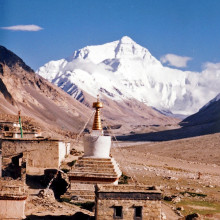If you're standing on top of Mt Everest, will your day be brighter for longer? Will there be more sunlight and why? Plus, we ask how many bees it takes to boil an entire person!
In this episode

00:00 - Does a mountain make the day longer?
Does a mountain make the day longer?
We put this to Dominic Ford from the department of physics in Cambridge:
Dominic - There are a couple of interesting differences in what you would see around sunrise and sunset on top of a tall mountain. First of all, there would be difference in how long the sun would spend above the horizon. You can think about that by imagining that the Earth is a ball and if you're standing on the surface of that ball, it appears like a flat plane. It covers exactly half of everything you can see. Whereas if you move away from that ball up a tall mountain, it starts to recede away from you and appear like a globe in the sky.
Now, the Himalayas aren't actually very tall in comparison to the radius of the Earth. Everest is about 9 kilometres high and the earth is 6,000 kilometres in radius. So that means that even at the top of Everest, this ball would only appear about 174 degrees across as compared to 180. So that would make a difference of about 10 minutes in sunrise and sunset times, if you assume that the Earth is a perfect sphere and Everest is the only mountain on the surface of the Earth.
Now in fact, that's not quite right because obviously, Everest is in the middle of the Himalayas, and you'll be familiar with the fact that if there's a tall hill on the horizon, then the Sun will set behind the hill somewhat before published sunrise and sunset times.
Diana - So on the top of Everest, the Sun wouldn't spend that much more time over the horizon because it would set behind the mountains, but what about the bit in between sunset and total darkness?
Dominic - Now, there's a slightly different answer because when we talk about hours of daylight, we tend to be talking about when we perceive it gets light, and when we perceive it gets dark, rather than when the Sun is rising and setting. That's to do with twilight times and how long the sky appears bright after the Sun has set. In the UK, we're quite used to having a lot of twilight and that's to do with the fact that we're at a high European latitude and when the Sun sets, it sets at an oblique angle, and it actually spends quite a long time sitting on the horizon as it's setting.
Everest of course is close to the equator and at equatorial latitudes, the sun sets more or less vertically downwards. So it sets very quickly, and you don't have much twilight time as the Sun is setting.
Moreover, twilight is caused by the scattering of sunlight off particles in the Earth's atmosphere and at the top of Everest, you're above most of the Earth's atmosphere. So, you have a lot less light being scattered and twilight will appear a lot darker. So once the sun has set, it will get dark relatively quickly compared to what we're used to. So you might find actually, there's slightly less daylight time on top of Everest than you would see certainly here in the UK.










Comments
Add a comment